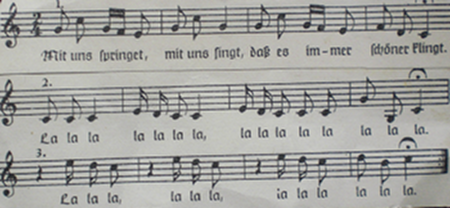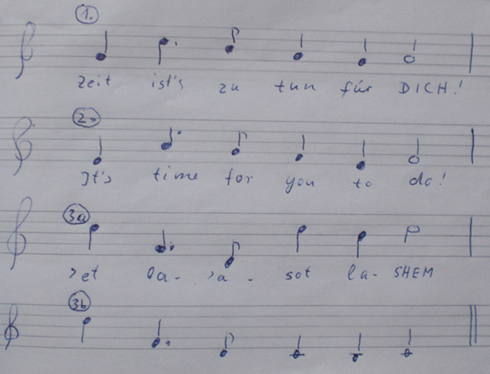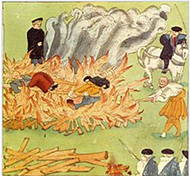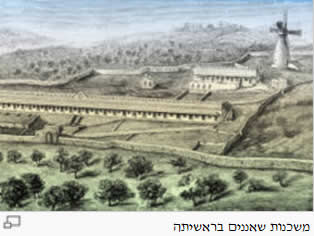|
InteGRATion into
GRATeFULLness
Singing&Sounding keeps me Sound
German and Hebrew Canons
| 2007_12_29 |
The
amount of Hebrew songs created in the last 100 years in Israel is incredible, but one genre is sadly underdeveloped: the Canon. Singing together in 2 or 3 or 4 or 5 voices was an almost everyday activity, while I lived in Germany (from 1938-1964). |
I'll
list the most beloved canons on this page. I would like - in time - to sing the tune of each, but singing them alone doesn't make sense. A chance - Oct. 19, 2010 - to sing part of the canons t o g e t h e r, was with Regina, the eldest daughter of Ursula, my late sister. Ralf, her husband, joined in, and sweet and loving as this was, it made recording impossible, since he sang so out of tune! |
Hebrew Canons, which I sing with one voice only, my
own:
Not yet recorded and inserted:
|
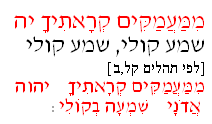
Second stanza - Dec. 2012 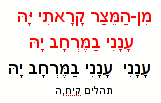
Psalm 130:2 and Psalm 118:5 |
Already recorded and inserted: |
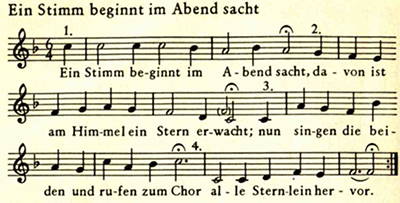
May 13, 2013 Thanks to Martin, my dead sister's husband, who finally helped me to remember this excellent canon. Thanks to Martin also for finding Canons for me, which were missing in my ABC List: : B: Bona Nox- C-Cantate - J: Jubilate - N:Nacht bricht an - P: Pacem - T: Tanz rueber - Z: Zieh mit der Sonne |
Mit uns springet,
mit uns singt |
German Canons, which I sing with one voice only, my
own:
| Abendstille
ueberall
|
Frère
Jacob,Frère Jacob Ich will den Herrn
loben |
Pacem
Zeit
ist's - Ps.
119:126 - June 26, 2013
|
I asked Regina's father about them.
One title "Ein Stimm beginnt zu klagen" at first didn't remind him of a canon but of a song: In stiller Nacht,.
The tune is by Brahms, my favorite composer,
and the sad lyrics are by the Jesuit Friedrich Spee von Langenfeld (1591-1635),
a man "out of the box", who should have been sanctified by his church, but never was.
I had seen a moving youtube "Ein Stimm beginnt zu klagen" about this man just 2 days ago
when I had searched for that canon myself,
but grasped the meaning of this title only after I got that mail from Martin about " In stiller Nacht,"
I'm now learning the song by heart from a performance by the Brussel Chamber Choir and am moved even deeper,
though the sadness "belongs" to my earlier life,
like the lines about the moon that does no longer want to see the suffering on Earth.
During the Eichmann Trial in Jerusalem in 1961 I often looked at the moon and screamed:
"Why could you see AUschwitz and still go on shining?"
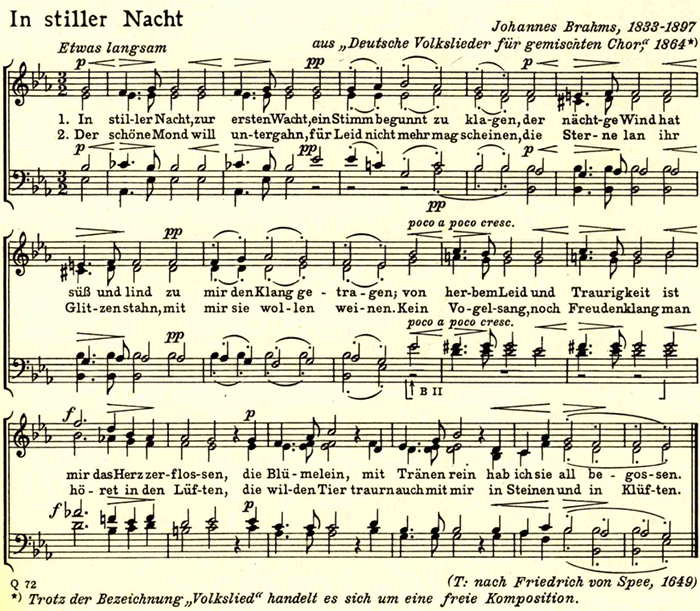
| In stiller Nacht,
zur ersten Wacht, ein Stimm' begunnt zu klagen, der nächt'ge Wind hat [süß] leis und lind*) zu mir den Klang getragen. Von herben Leid und Traurigkeit ist mir das Herz zerflossen, die Blümelein, mit Tränen rein hab' ich sie all' begossen. Der
schöne Mond will untergahn, |
[See
the original poem "Trawer-Gesang von der Noth Christi am Oelberg in dem Garten" (Mourning-Song of the Suffering of Christ on the Mount of Olives in the Garden) I, Christa-Rachel, always understood, that "Gethsemane" symbolizes all human suffering. See my book -----the chapter: "The identification of the Sufferers with the Crucified" I learnt the song on my way to the pool, as usually, except that the tune is so easy, that I learnt it quickly. Just when I took out the water bottle next to the "Grave of Compassion", where I recently started to spread "good" earth from my garden and to plant cuttings from those flowers - like Geranium - that do not need roots in order to become rooted, I sang, while watering the Grave: die Blümelein, mit Tränen rein hab' ich sie all' begossen. And when I came out of the pool, walking the first 300 m or so through the street along the ugly houses, built when this town, Arad, was founded in 1962, I heard - together with the line on my digital recorder about "kein Vogelsang" - among all the cooing of the pigeons- an unfamiliar sound from a bird high up on a street-lamp. I pulled my glasses out of my backpack and there it was - a green-yellow Tucki [parrot]! I've seen these jungle-cage birds once before here, but that one of them would shriek exactly when the song sang "no bird-song nor sound of joy", was exhilarating, just like it was exhilarating that I watered "my" grave (once a military pit in the desert) not with"pure tears", but with pure tap-water, provided by Arad's Municipality! |
In
the quiet night, at the first watch,
a voice began to lament; quietly [sweetly] and gently, the night wind carried to me its sound. And from such bitter sorrow and grief my heart has melted. The little flowers - with my pure tears I have watered them all. The
beautiful moon wishes to set *) I understood this line differently: |
He asked his friends, the German Andreas Scholl, countertenor,
and his Israeli wife, Tamar Halpern, pianist,
if they knew of lyrics that would fit the tune.
They suggested : In stiller Nacht, obviously without knowing its origin.
Tamar explained in channel 23, "Intermezzo", that it was about a lonely woman....
| I
feel so attracted to this man, that I studied Wikipedia
about Friedrich Spee: "an opponent of trials for witchcraft. Spee was the first person in his time who spoke strongly and with arguments against torture in general. He may be considered the first who ever gave good arguments why torture is not a way of obtaining truth from someone undergoing painful questioning. ...the Cautio Criminalis did bring about the abolition of witch-burning in a number of places, especially at Mainz, and led the way to its gradual suppression. The moral impact created by the publication was considerable. Even in the seventeenth century a number of new editions and German translations appeared. Among the members of Spee's Jesuit order his treatise found a favourable reception. A memorable observation in the book suggests that Germany and England must have more witches and devils than Spain and Italy since there are so many more stake burnings in the former. This may have been a not so subtle criticism of Protestant reform Europe which he believed was guilty of even greater abuses than the Catholic countries. [This is - by the way - another proof of the dynamics in history , that any "betterment" that is accompanied by denial and repression- soon leads to a regression],The book is still in print See for instance my talk with Meirav:"Only this will cause tikkun-olam! All the big manifestations for bettering the world - since they were mingled with so much denial - had their setbacks, their regressions, the evil that came out of the good." |
Right after having written my assumption |
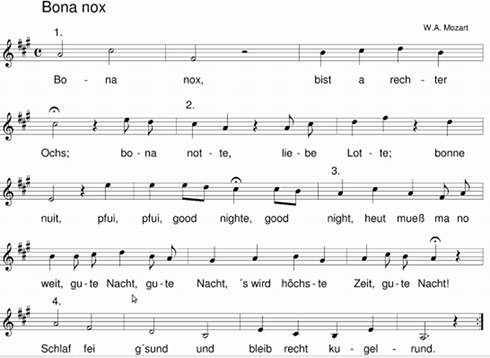 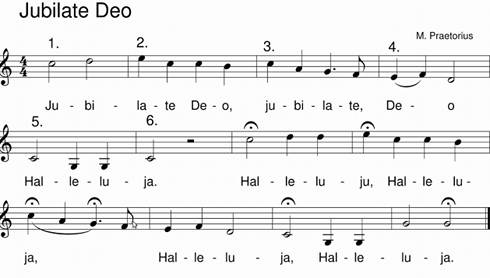

|
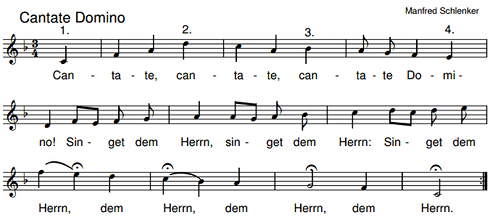 I changed the German part into the Hebrew original, also in order to escape the terrible "dem Herrn", the "Lord". 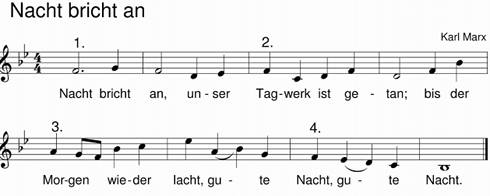
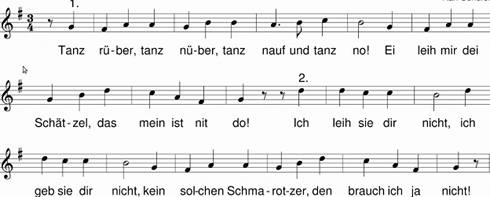

|
Juni
26, 2013 - Lieber Martin, Der letzte Kanon-Brief, also - Du scheinst ermuedet! Der Kanon mit Z "Zum Geburtstag" hat mich
nicht beruehrt. Die Melodie fuer die erste Zeile - in deutsch - war
sofort da, So nun darst Du "von Deiner Arbeit ruhen". Rachel |
|
Back to 2010
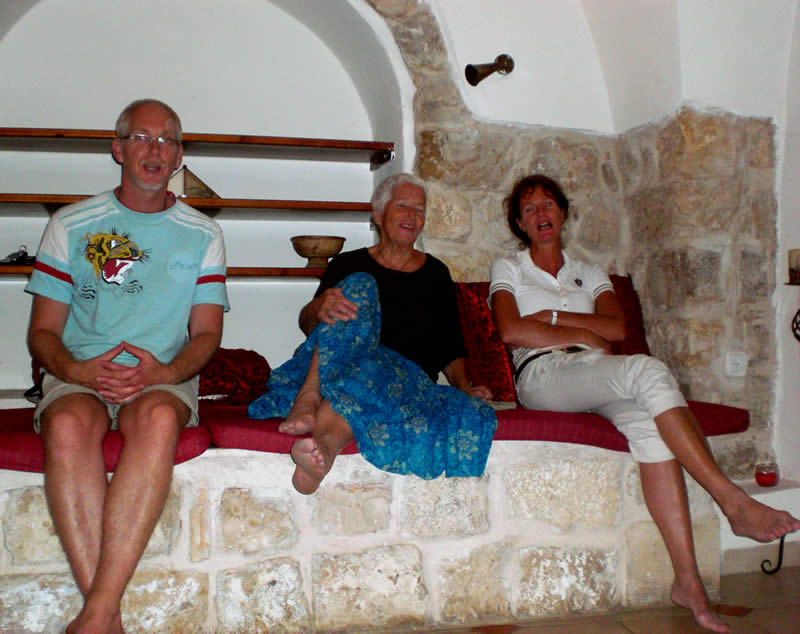
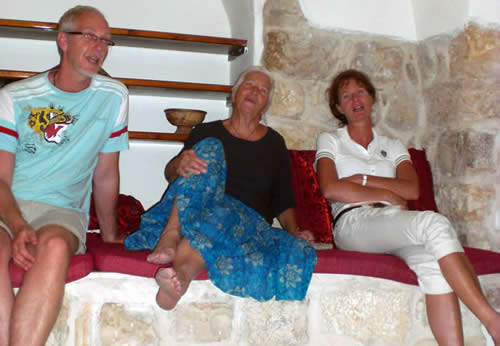
With Regina and Ralf in Gita's and Ronny's B&B castle at Safed, on October 19, 2010,
singing canons, photographed by their twin daughters who no longer know canons....
Ich lieb dich so fest, wie der Baum seine Aest, wie der Himmel seine Stern', grad so hab ich dich gern. [Learnt from my mother some 50 years ago, relearnt and recorded on July 18, 2010] I love you so strongly, like the tree its branches, like the sky its stars, just like that I love you. |
 
|
![]()
2010_10_24-27
[see the
main 2 pages about the visit of my German family, with links to several
branches]
Because of our singing canons together, me, my mother's
daughter, and Regina, my mother's granddaughter,
I re-use this page for a composition of photo-experiences in the graveyard
of my mother - on October 15, 2010.
This was the simple idea, when I began editing, sculpting, composing. Yet
something far vaster came out of it...
A sculpture of old photos may precede this "Driving
Backward" to dead people, who once lived in the holy land.
And a sculpture of new photos - made by my German family when they visited
us from Oct.12-22, 2010- will follow.
While sticking to my limit of 1300 kb per page, I see with wonder, how and
in what order these 7 pages were filled!
![]()
|
SongGame 2007_12_29 |
SongGame
2007_12_26 German Christian Hymns |
SongGame
2007_12_25 Stille Nacht |
SongGame
2007_12_23 Ihr Kinderlein, kommet |
SongGame
2007_12_22 Es ist ein Ros entsprungen |
SongGame
2007_12_24 Ich steh an deiner Krippen |
SongGame
2007_12_28 Jewish Festival Songs |
My last visit of my mother's grave was in September
2003.
In my archive of photos I noted: "Probably my last Visit".
Now I learnt, that the integration of Cross and David-Star,
(Ursel: "our mother had a Jewish and a Christian
daughter!")
is not so much a commemoration of my
mother's existence,
as it is a symbol for "Christa-Rachel"
and also a prophecy for the world.
A composition of photos may precede my 2010 sequence.
First Part: 1963-1983
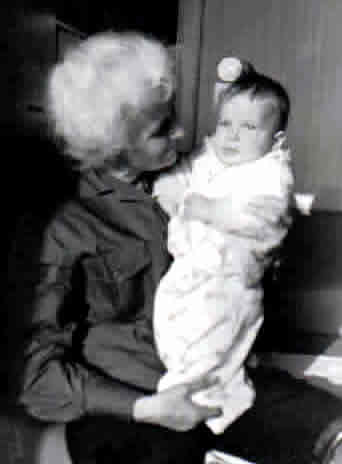 |
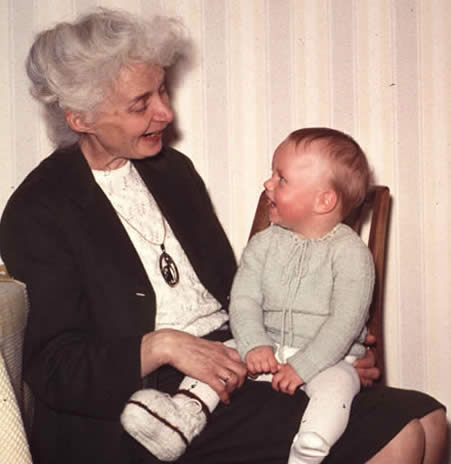 |
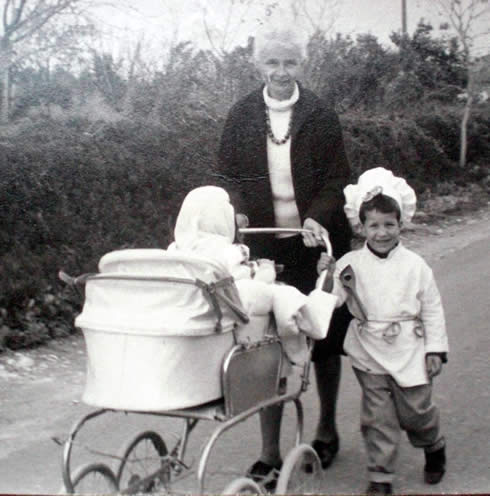
Israel, March 1967, Maria Guth with her three grandchildren in Purim costumes, shortly before her stroke.
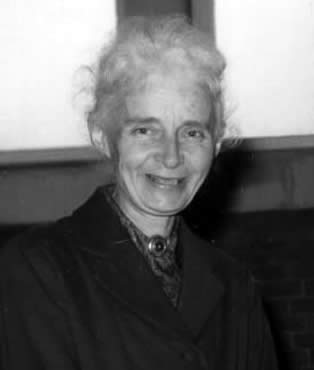 |
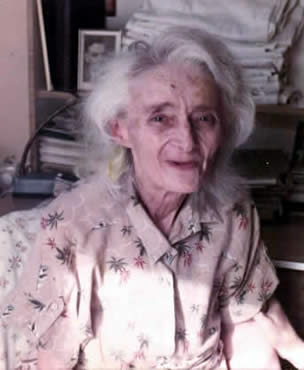 |
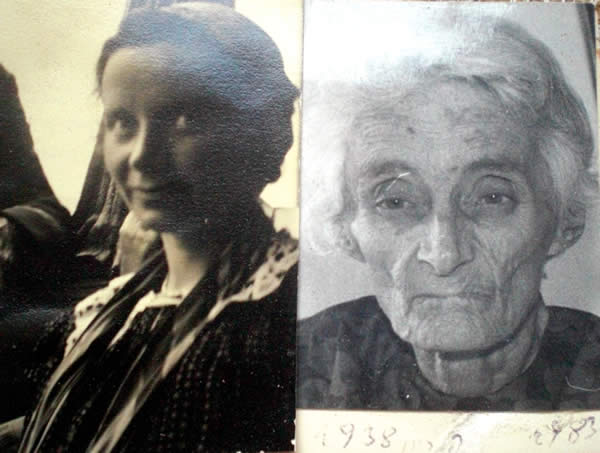
An old paper composition: Maria Guth 1938 (pregnant with me) and 1983-1985 (cared for and dying in my arms)
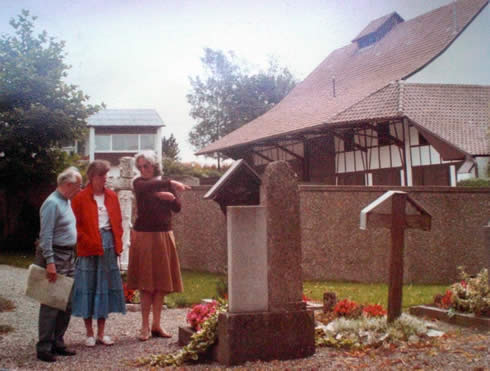 |
.jpg) Another graveyard - in Wolfartsweiler, where my mother + 3 children were evacuated 1944-1946, I visited it -1983- with Regina and a friend of my father (fell in 1943), who had proposed to drive us. |
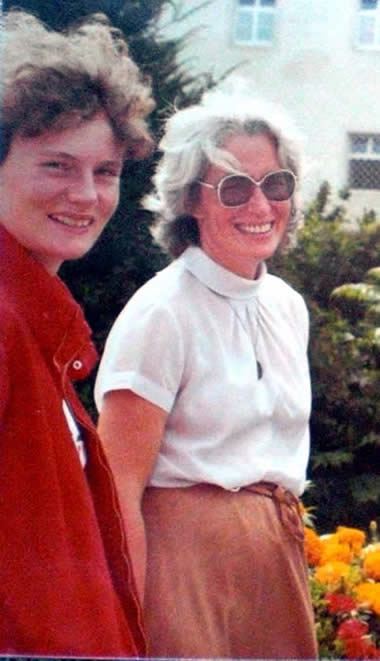 |
This
occurred when I lived with Ursel for 4 weeks, and visited our mother
at Calw hospital every day
(by bike: 10 km), until it became clear that she would not die, but come into my care in Israel, from July 1983 till she died, Febr. 1985 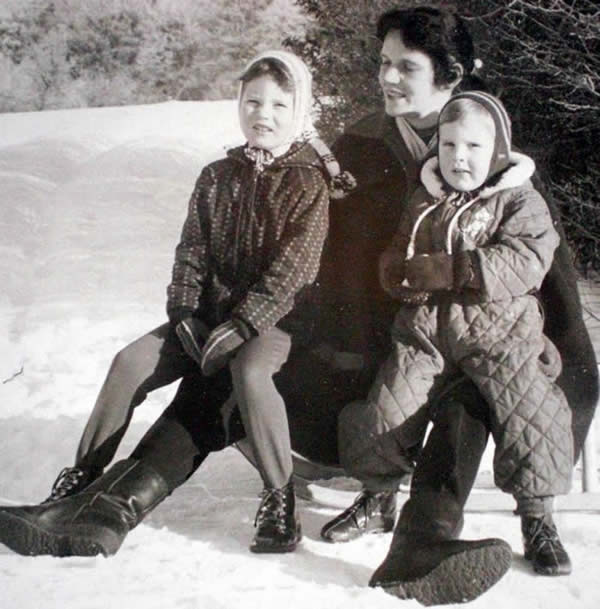 Ursel, my sister, with Regina and the second of her 4 children, Hartmut, perhaps 1968 |
Second Part: 1985-2003
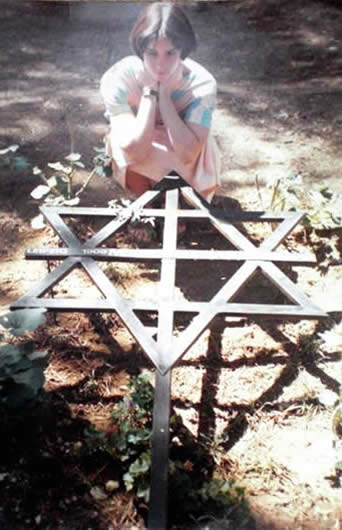 |
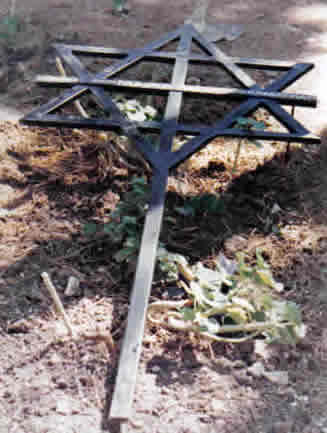 My mother died in my arms ~~~ on Februar 20, 1985. We buried her in the Templers' Cemetery in Jerusalem and later installed this integrated Cross and David-Star (see more in K.i.s.s.-Log 2008 on Maria's birthday date) My daughter Ronnit tried to bond with her grandmother, though Maria didn't even recognize me. her daughter. Yanina and my main Arab partner in the seventies helped me to install the sculpture. |
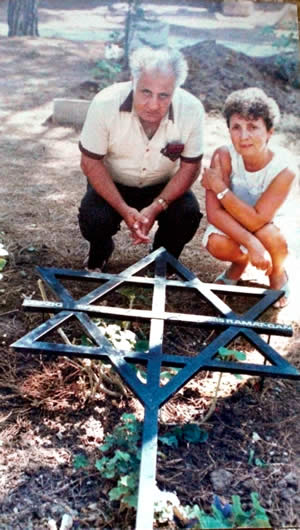 |
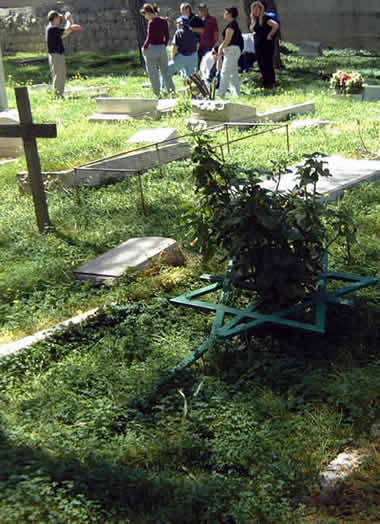 |
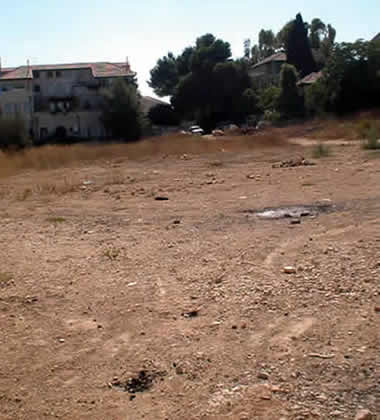 What a contrast in Jerusalem between the green graveyard in 2001 and this nearby spot in Sept. 2003. The dry spot was where my bus had parked for 4 weeks in May 1988. As far as I could see now -2010- that "parking-lot"has become part of "Bell-Garden". I wonder, if the guide of that group was Me'ir, the same Messianic Jew, who now, on Oct.15, 2010, utterly elated, told me and my German family: |
"For 10 years groups have been asking me about
this grave of Maria Guth,
and I tell them: I know nothing about her, but she must
have loved Israel!"
Third Part: October 15, 2010- between 2:15 and 2:45
PM
Though we met Me'ir only, when we all arrived from
the Brith
of Tamir's son,
[.... from Birth and Brith to Burial ....]
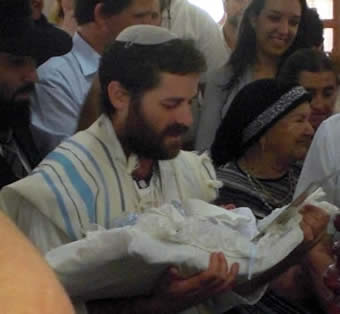
I need to mention Me'ir before taking you on
a virtual early-morning-walk through the tomb-stones.
In the morning my old key had opened the gate, but now I had forgotten it
in my family's rented car.
Yet - when we came - driven by Yacob of Tamir's family- the
gate was wide open, for the first time in 25 years!
I hurried inside, ran to the third grave in this row and there was Me'ir exclaiming:
"Who are you?"
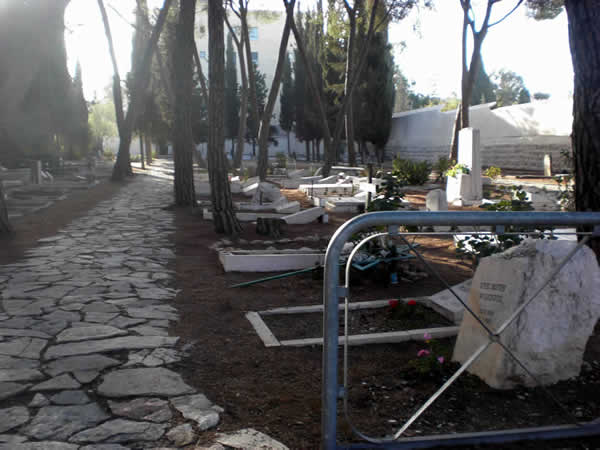
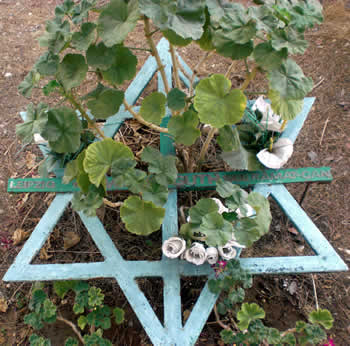
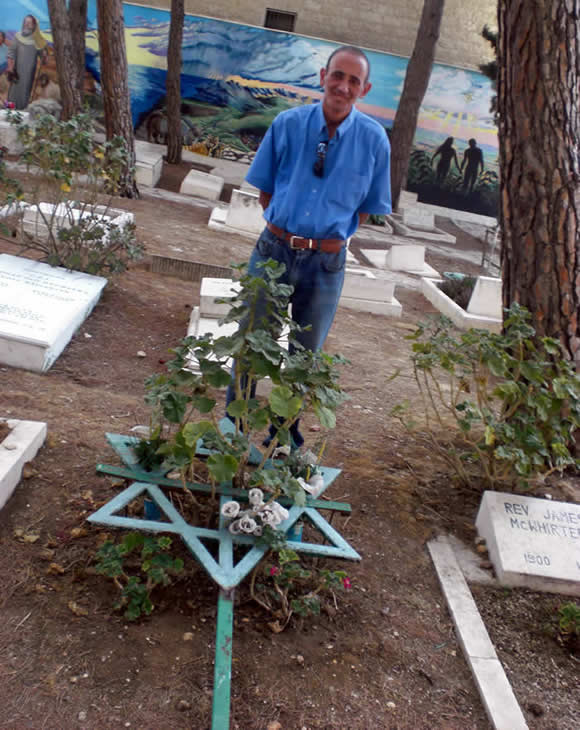 |
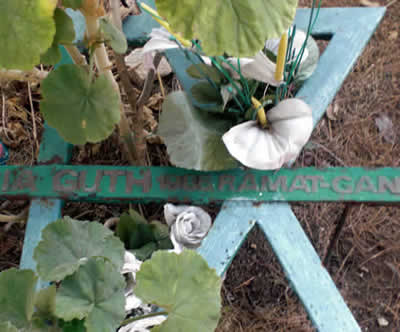 Meir: "You should restore the rusty and broken sculpture! And you should replace the plastic flowers, which I put here, with two bushes of roses!" [See the rose-triad I planted for my kids]... 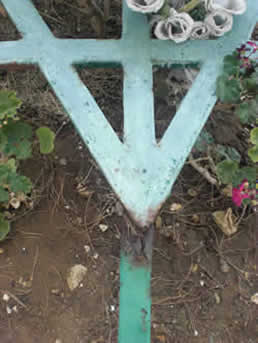
|
A messianic Jew guards and guides in a graveyard of Christians,
Christians, who were expelled by the Church because of their belief,
Christians who left everything in the area, where I was born and grew up,
Germans, who immigrated to what 100 years later, when I
myself immigrated,
had once more become
ISRAEL!
An e-mail quote arrived in this very moment [Oct. 27, 2010,
8 AM ] of my last work on these 4 pages
|
As you are born into these physical bodies, you experience the vibrational continuum of the generations that have come before you. Their desires as they have lived as individuals —and their Collective Mass Consciousness desire— has emanated to the boundary-less boundaries of the Universe, and Law of Attraction is answering all of those requests. So, each generation who follows the previous generation benefits by the desires that have been exuded by Mass Consciousness. Abraham [2004] |
While rejoicing in the fact, that Me'ir cared like a son for Maria Guth's
grave,
it dawned on me, that my and my sister's iron symbol of Cross+Star-of-David
must have entered body and heart, if not the consciousness of many people!
And I began to wonder, why I am to learn about this at this moment in time?
 |
May
2, 2011 There are still "problems" with realizing Meir's wish. ...........!!!!! On the background of world events like the "end-time promo" in Japan (since March 9), and the dumb reaction to the killing of Bin Laden now, it would be ridiculous to quote the CMA's "rules". In any case, if Maria Guth would have died today, she wouldn't have been "qualified" for being buried here, nor would I have had the required 3000 dollar for burying her in Jerusalem..... |
I now was to have another experience in those 30 minutes of Oct. 15, 2010:
In all these 25 years I never had a chance to enter the
split-off section of the cemetery,
which seems to "contain" only the graves of the
original Templers,
those people who came from "Schwaben",
or as it's called officially: "Wuerttemberg",
precisely in "my" Germany around Stuttgart, where I was born and
raised
and Wolfartsweiler near Saulgau [see
map] to where we were evacuated (1944-1946)
They came exactly at the time, when the brave Jews in Jerusalem broke through
the walls,
and erected Mishkenot
Sha'ananim [see also the website of Mishkenot
Sha'ananim today, and see my
own experience]]
I want to believe, that not all of these "Landsleute" ("the
people of my country") were Nazis,
though all of them - up to the last family - were evicted by the British Mandate
Government.
|
|
February
20, 1988, exactly 3 years after my mother's death I found myself for
a few days in the two Templer settlements, Waldheim (today Aloney-Abba) and Betlehem-in the-Galilee !! Strangely- there even exists a composition of photos about the visit of my children there. 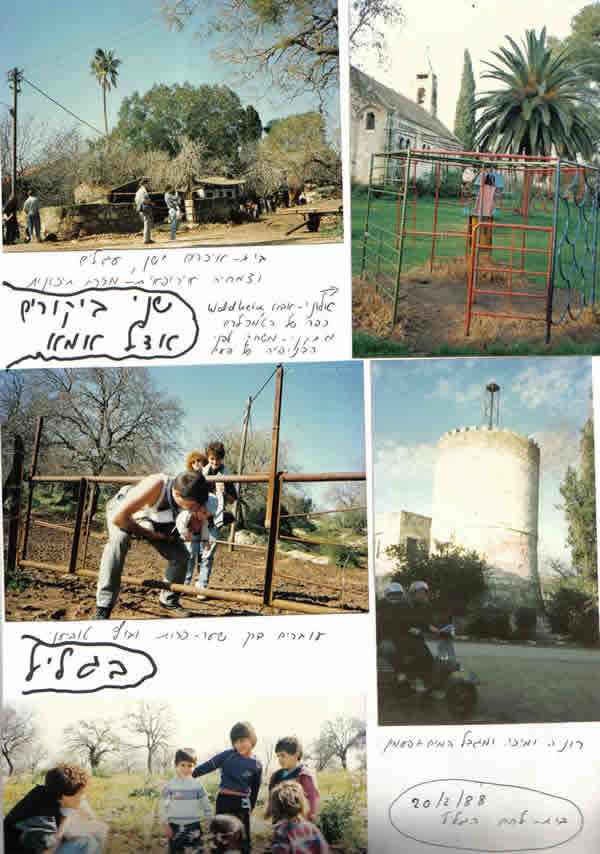
|
I want to voice my fantasy:
Was I Alexander Zaid, whose mother, a
Sobbotnik, was murdered, and who let himself be murdered on July 11,
1938?
Did I slip right away into the womb of a pregnant woman
from Saxony (the only other area in Germany with Templer communities)
in order to let myself be born only 35 days after Alexander Zaid's death,
hurrying, hasting towards the circumstances of this life-time?
I've always known, that it was necessary for my life's assignment,
that I experience the holocaust, though as a child,
from both sides, from the side of the victims and the side of the perpetrators!
And I always knew, that unless my father, a judge at the beginning
of his career, had moved from Communist East-Germany to liberal West-Germany,
I could never have gone to Israel for a scholarship year
and therefore would never have immigrated to Israel,
in order to live, what
that prophecy calls "godêr-paeretz", the one who repairs
a gap in a fence?
"and thou shalt be called the repairer of
the breach, the restorer of paths to dwell in".
But why did my parents come to Stuttgart, the base of the Templers in Germany?
And why did I, the child, whose parents did not talk with her the Suabian
dialect,
come in close contact with the children of the Suabian peasants, just when
my consciousness began to wake up?
[How short is the time of 2 3/4 years, when one is 72, and how long, when
one is six years old!!!!!]
From Me'irs brochure about the Wuerttemberg
Templers:
The Templers' decisive contributions to the country
during these early years were the building of new roads
and the improvement of the existing transport routes, because up to
then there was only one road fit for vehicular traffic, namely the
road the pildgrims travelled from Jaffa to Jerusalem. The road from Haifa to Nazareth was the first to
be built. The construction costs were largely carried by the members
of the Haifa Templer Community. The new road made relatively convenient
and safe pilgrim journeys to Galilee possible. Templer families built
and ran hotels in Haifa, Tiberias and Nazareth. Regular coach services
operated between Haifa and Acre, and between Jaffa and Jerusalem.
Where previously goods transport and travel were only possible using
beasts of burden, or boats along the coast of the Mediterranean, the
face of the country was now changing. The groundwork for the development
of a modern economy had been created. The Templer
Cemeteries: |
A few images of the section of the Templer graveyard,
where Templers are buried
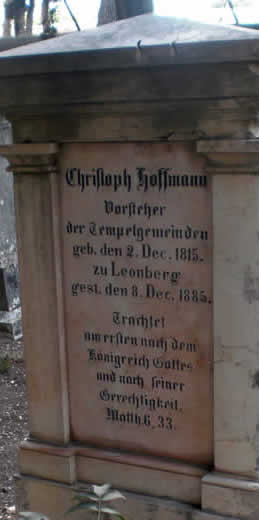 Father Christoph Hoffmann, 1815-1885 |
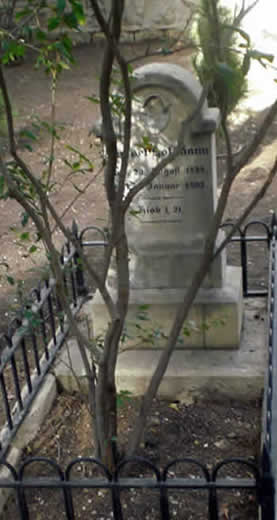 Samuel Hoffmann, 1888-1889 who died like the other children from cholera |
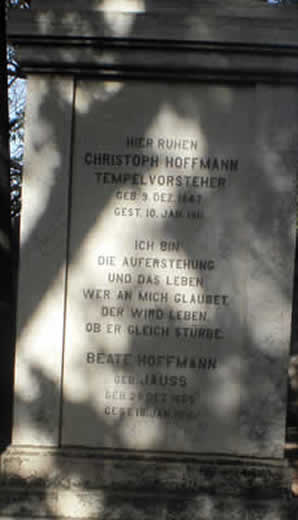 Son Christoph Hoffmann 1847-1911 |
Christoph Hoffmann senior and Christoph Paulus (1811-1893)
- from Ludwigsburg - were the founders of the group in 1854,
In 1868 Christoph Hoffmann and a few other families emigrate to Palestine
1884 Christoph Paulus succeeds Christoph Hoffmann as Head of the Society.
[see timeline]
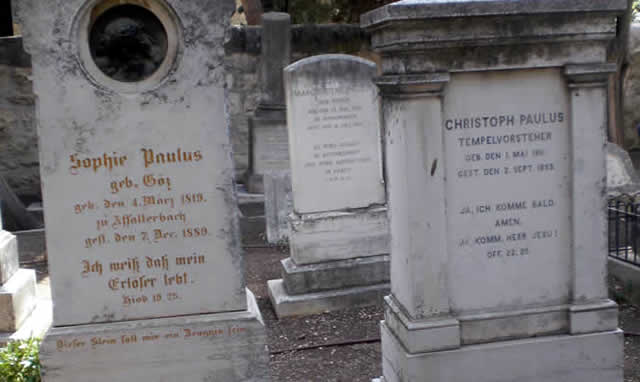
The children die in the Holy Land
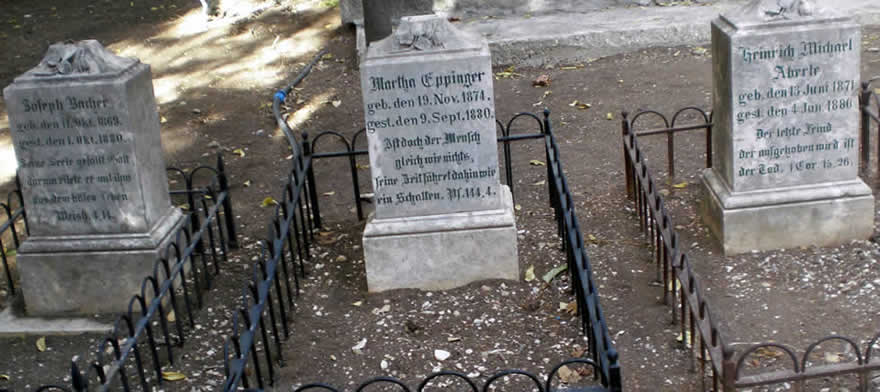
Three children graves in a row and more children
graves nearby:
one of them quotes: "the little girl is
asleep". [Matthew
9:24]
But in that Jesus-story the girl was resurrected to life...
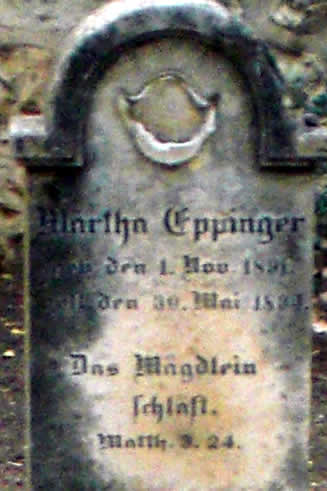 |
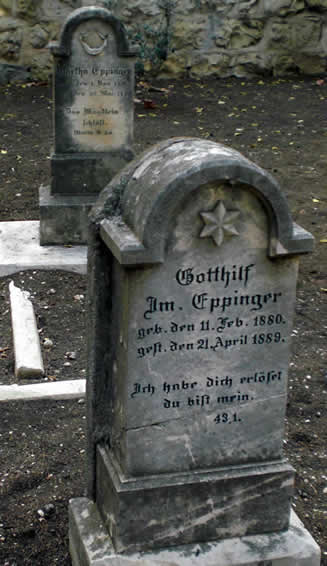 |
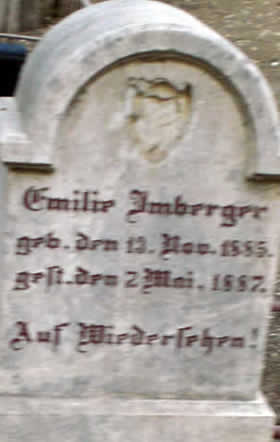 |
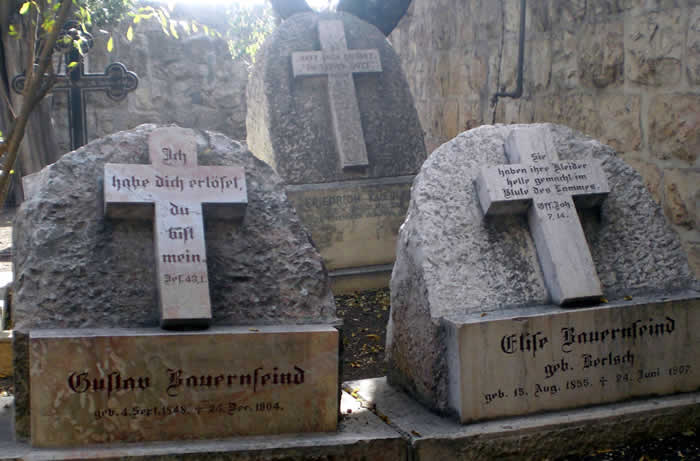
One of my two bosses at the Tuebingen
"Institutum Judaicum" was Prof. Otto Bauernfeind.
I was employed there for half a year after I was evicted from Heidelberg University,
1963.
Bauernfeind, "Enemy
of Peasants" conjures up the time of Martin Luther's "Reformation"!
Me'ir showed us this empty space on the wall above
a list of names: "Here was the relief of
a big swastika".
I don't know, how the names under it are connected, but those I could decypher
show fascinating wanderings:
like: Paul Guenthner
born in 1879 in Jaffa, died in 1920 in Stuttgart ~~and
like ~~ Jakob Mayer, born 1887 in Kirchen, died
1918 in Nazareth.
or : Joh. Wennagel, born in Sarona 1884, died in ? 1914 - The landlady of
the flat in Stuttgart, into which we were re-evacuated in 1946, was called
Frau Wennagel
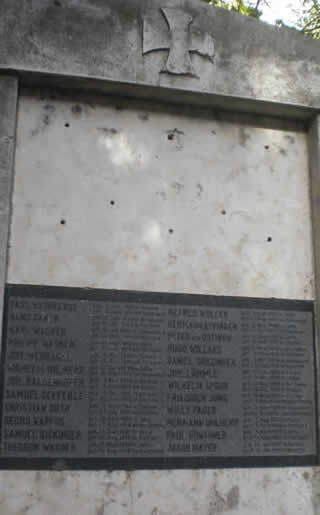 |
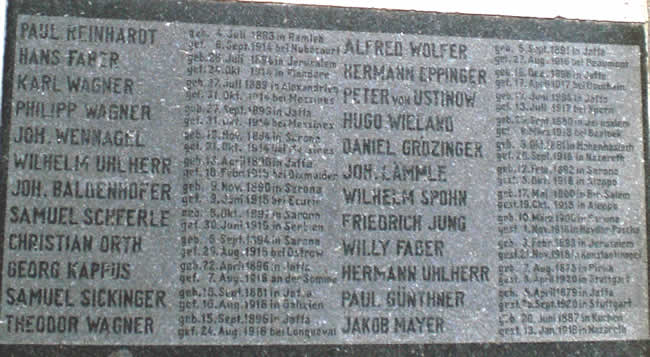 Nazi affiliation [from
Wikipedia Sarona]
Nazi affiliation [from
Wikipedia Sarona]"During the 1930s, with the rise of the Nazi party to power, many of the Templers embraced Nazi ideology. Nazi party branches where established in every colony and Nazi official, diplomats, gestapo and S.S. officers – including Adolf Eichmann – visited Palestine and were received with great enthusiasm by the men and women of Sarona. About a third of the Templer colonies registered as supporters of the new rule and become Nazi party members. Nazi youth movement activities were popular and the plans to open schools based on Nazi ideologies turned the once-friendly Jewish Yishuv away and Templer produce was boycotted. At the end of August 1939, a few days before World War II broke out, young Templer men eligible for the draft were conscripted into the Wehrmacht and left for Germany. Those who stayed behind became enemy nationals.[4] Sarona, together with the three other agricultural settlements - Wilhelma, Bethlehem of Galilee and Waldheim - became "perimeter" compounds into which all Germans living in Palestine were interned. Sarona held close to 1,000 persons behind a guarded, 4 m high barbwire fence. In July 1941, 198 people from Sarona, together with almost 400 from the other internment camps were deported to Australia on the Queen Elizabeth. They were interned in Tatura in Central Victoria Australia until 1947. By November 1944, most of the remaining Sarona residents had been moved to the camp in Wilhelma camp. The last group was sent there in September 1945." |

